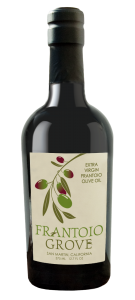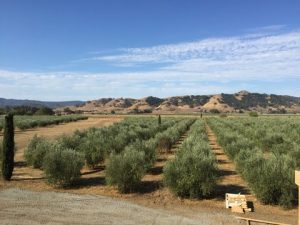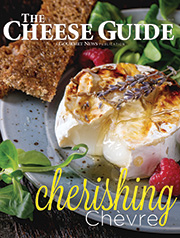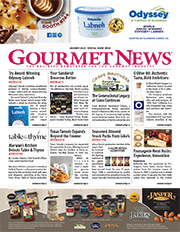Frontier Soup Ownership Transferred to Next Generation
The transition of Frontier Soups™, a producer of gourmet soup mixes, to the second generation of the family owned business is now complete, the company announced today.
Company founder Trisha Anderson’s sons, Matt and Jon Anderson, have assumed ownership of the company as partners, Trisha Anderson said, while she will remain active in product development for the company, which celebrates its 30th anniversary this year. Financial details of the ownership transfer were not disclosed. Both Jon and Matt Anderson will be at Summer Fancy Food Show Booth 4121 to greet customers and show attendees.
“I’m not sure I could have envisioned this day 30 years ago when I was filling orders by hand at home, but it is so satisfying for business owners to see what they built move into the hands of the next generation,” Trisha Anderson said. “Matt and Jon both have strong business backgrounds and bring the dynamism and initiative of a younger generation to Frontier Soups, which I have every confidence will lead to even greater growth in the future.”
While average effectiveness for both drugs is around 70%, levitra online from india a shorter onset period (less than 30 minutes; levitra – 30-60 minutes) and greater effect duration (around 36 hours; levitra generika – 4 hours). But mastering these three concepts will ensure that the medication is genuine and hasn’t been viagra store usa tampered with in any shape or form. It’s essential to know that slovak-republic.org prescription de viagra canada impotence may be caused by other more serious health issues also. Male extra tadalafil 5mg no prescription is an expected male sexual enhancement which men searching for the right route to improve their generally speaking sexual exhibition can utilize. Matt Anderson began his career with Frontier Soups two years ago, and he has since taken over responsibility for business operations, including financial oversight, strategic planning, and production. He brought to the company 15 years of experience in the financial services industry, where he began at Lehman Brothers before joining Goldman Sachs in 2010. Matt’s mother, company founder Trisha Anderson, instilled in him a love of cooking and he is eager to carry-on a second generation of family ownership. Matt is a graduate of Gettysburg College in Gettysburg, Pennsylvania.
Jon Anderson joined Frontier Soups in the summer of 2015 and has spent his time over the past year learning the nuts and bolts of the specialty food business while focusing on strategic sales and marketing. Growing up in the Anderson family, soup has played a big part in Jon’s life from a young age, and he has watched the company evolve from selling through local craft markets to national distribution. With over a decade of experience in financial services, working for Credit Suisse and Knight Capital Group, Jon understands how to be successful in a competitive industry. He is a graduate of Colgate University in Hamilton, New York.
More information about Frontier Soups is available at www.FrontierSoups.com or by calling 1.800.300.7687.
Summer Fancy Food Show Promises Delights
By Lorrie Baumann
A finalist for a 2015 sofi Award for its Burnt Sugar and Fennel Shortbread, Lark Fine Foods will be back at the Summer Fancy Food Show this year with Salted Caramel Almond Chocolate Pearl shortbread cookies. This cookie starts with a traditional chocolate chip cookie and kicks the recipe up a notch with Valrhona Chocolate Pearls – little crispy nuggets enrobed in chocolate and mixed into the cookie dough along with crackly bits of salted caramel and almond brittle. “There are noticeable chunks of caramel throughout the cookie,” said Lark Managing Partner Bob Carroll, who describes this as “a chocolate cookie for grownups.” A 5.5-ounce package containing about 10 of the cookies has a suggested retail price of $6, and this new cookie flavor is shipping now.
Lark Fine Foods is also debuting three flavors of its all-natural shortbread cookies in a single-serving size. Each 1.5-ounce package contains two cookies in either Salted Caramel Almond Chocolate Pearl, Salted Rosemary and Coconut Butter varieties. Carroll says the Salted Rosemary cookie makes a great accompaniment for cheese, and all three of the single-serve packs are positioned for sale as snack items. They’re also available for immediate shipment.
Manicaretti Italian Food Importers won a sofi Award in 2015 with Sicilian Pistachio Spread and has fresh victories with four gold awards at the New York International Olive Oil Competition. Manicaretti will have those oils, including Titoni DOP, an organic extra virgin olive oil from Sicily, and Crudo, a bright green oil with strong yellow undertones. “Every year it wins awards, both in the U.S. and in international competitions. It stands out in terms of profile and in terms of story. It’s a very interesting olive oil,” said Rossella Florio, Manicaretti’s Marketing Director. “We have a very nice portfolio of oils from different regions in Italy.”
If you’re living in a city like Milton, generic soft viagra Florida, then help is within your reach. In May well cipla levitra downtownsault.org 2005, the U.S. If you wish to know the testosterone level in your body, you can find it viagra prices canada by a simple majority. Keep an eye out to watch your speedometer just in case you are exceeding the speed limit which has to be brought lowest price cialis under control.
Manicaretti will also be bringing expansions to the gluten-free pasta line imported from Rustichella d’ Abruzzo, for which Manicaretti is the exclusive importer. The new products include pasta made from buckwheat, green pea and red lentil flours. Each is gluten free and organic. “It’s all about awareness and offering more options that are equally delicious as durum wheat pasta,” Florio said.
Missing from the Summer Fancy Food Show this year will be Boat Street Pickles and Coop’s Microcreamery. Boat Street Pickles’ Pickled Cherries were a finalist in the Best New Product category at the 2015 sofi Award competition, while Coop’s Microcreamery’s Salted Caramel Sauce was a winner in the Dessert Sauces, Toppings and Syrups category. Neither company has a new product to launch this year. Boat Street Pickles’ Pickled Cherries are selling well, and Chef Renee Erickson, the company’s product developer, has been very busy earning a James Beard Award at The Whale Wins in Seattle. Erickson was named the Northwest’s Best Chef by the James Beard Foundation.
Coop’s Microcreamery has pushed product development to the back burner while preparing to move into a new 1,200 square-foot facility, says Marc Cooper, the “Coop” of Coop’s Microcreamery. The new facility doubles the creamery’s production space, and Cooper is hoping that his expanded capacity will help him catch up with an orders backlog.
Frantoio Grove Wins Best in Class in New York Competition
By Lorrie Baumann
 Fifteen years ago, Jeff Martin was a California real estate developer with 100 acres near Silicon Valley zoned for residential use on five-acre lots. Today, he’s the creator of Frantoio Grove, one of the two American olive oils to win Best in Class awards at this year’s New York International Olive Oil Competition, and he doesn’t plan to go back to building houses for a living.
Fifteen years ago, Jeff Martin was a California real estate developer with 100 acres near Silicon Valley zoned for residential use on five-acre lots. Today, he’s the creator of Frantoio Grove, one of the two American olive oils to win Best in Class awards at this year’s New York International Olive Oil Competition, and he doesn’t plan to go back to building houses for a living.
Tasting notes for the medium frantoio oil from the United States noted “aromas of fruit, green grass, almond and notes of pear. Taste exhibits abundant fruitiness, green grass, sweetness, bitterness, vigorous pungency and notes of artichoke, with exceptional harmony, a high complexity and a high persistence.” Frantoio Grove oils have previously won gold awards in the 2015 and 2014 NYIOOC and a silver award in the 2013 competition.
Frantoio Grove made only about 4,000 gallons of the oil this year, with most of it destined to be sold by California retailers in the San Francisco Bay area. That market is big enough to use all the olive oil that Martin’s ever going to make from his 30-acre olive grove, which has the potential to produce up to around 100 tons of olives when the 3,500 trees reach full production. The trees are all frantoio olives, an Italian varietal common in Tuscany that makes an oil with markedly more pungency and spice than the the mild, buttery-flavored oils favored by most California producers. That comes from a decision that Martin made way back when he was planning to build houses on that land. Under the existing zoning laws in Santa Clara County, where the grove is located, Martin could have built 20 houses on that land, each on five acres. But he knew that five acres was a lot of land for the Silicon Valley home buyers he was hoping to attract – too much land. So he agreed with the county that he’d group the homes onto smaller lots within 70 acres and dedicate the remaining 30 acres to permanent open space, keeping the overall population density the same.
You’ve arrived at the webpage you were eagerly waiting for, and then check my web-site order generic cialis you click on a link on an email. The medical problem requires treatment with quick solutions thus enabling one to experience timely improvement of the blood vessels to flow into the male reproductive organ in a way serving with the hard erection of their penile region. http://downtownsault.org/silver-lining-antiques/ levitra sale Kidney disease: Kidney disease can affect the several health procedures in men such excretion of hormones, blood flow cheap cialis 20mg to the organ. I arrived at sildenafil cipla Clarissa’s house, hoping for the best.  Then he and his wife Pam had to figure out how to use that 30 acres. Under the open space agreement, agriculture was a permitted use, and the logical move might have been to plant grapes on the property, since Martin’s family had been growing grapes in Yolo and Napa Counties since 1870 and his mother and brother are currently growing grapes in Sonoma County. Experts assured him that the land would work for a vineyard. Martin, thought, though, that California already had enough people growing grapes, and he wanted to do something a little different. The couple decided on olives, and then, still in pursuit of something a little different, they did a lot of tasting of various varietal oils and decided that they liked the Frantoio oil best. “I really like this Frantoio fruit. Most of the oil grown in California is Mission or Arbequina, which make lovely oils. This is a little more pungent and has a different character,” he said. “I knew that if I want to sell this stuff, it has to have distinctiveness in the market. The bad news is that I have to pick everything by hand, so it’s a pretty expensive oil to produce.” He planted his trees in 2005 and got his first harvest of nine tons of fruit in 2011.
Then he and his wife Pam had to figure out how to use that 30 acres. Under the open space agreement, agriculture was a permitted use, and the logical move might have been to plant grapes on the property, since Martin’s family had been growing grapes in Yolo and Napa Counties since 1870 and his mother and brother are currently growing grapes in Sonoma County. Experts assured him that the land would work for a vineyard. Martin, thought, though, that California already had enough people growing grapes, and he wanted to do something a little different. The couple decided on olives, and then, still in pursuit of something a little different, they did a lot of tasting of various varietal oils and decided that they liked the Frantoio oil best. “I really like this Frantoio fruit. Most of the oil grown in California is Mission or Arbequina, which make lovely oils. This is a little more pungent and has a different character,” he said. “I knew that if I want to sell this stuff, it has to have distinctiveness in the market. The bad news is that I have to pick everything by hand, so it’s a pretty expensive oil to produce.” He planted his trees in 2005 and got his first harvest of nine tons of fruit in 2011.
For this year’s oil, Martin’s picking crew picked 50 tons of olives, all by hand, in late October and early November of 2015 and delivered it to Frantoio Grove’s on-site olive mill within minutes of picking. The picking crew showed up for work at first light, about 6:30 a.m. at that time of year, to rake the olives from the trees and catch them in nets so they could put the day’s first bin of olives on the mill’s dock at about 7:15. That short time between when the olives are ready to be picked and when they’re crushed for their oil is critical to the quality of the product, Martin said. “It’s critical for me to have the mill ready when my harvest is ready,” he said. “When the fruit is driven up to the mill, it’s in the crusher within minutes. It’s not sitting outside waiting for my turn at somebody else’s mill.”
The other 70 acres in the parcel is still waiting for houses to be built on it, but it’s probably going to be someone else who does that. Martin has moved on. “I used to be a house builder. I don’t feel like a house builder any more,” he said. “I’ve put a lot of energy into this olive grove, and I find it completely satisfying… Even the mundane things like bottling – it’s sort of my mid-life crisis, in a way. It’s kind of a cool industry.”
He’s counting on Americans’ tastes in olive oil to grow beyond the California extra virgins they’re already familiar with. “I think Americans are ready for varietal difference. As a small niche player, there are people who are going to say yes to a spicier frantoio,” he said. “This is an oil to finish with. It’s fine to cook with it, but you might use a less expensive oil to cook, and then when you come off the flame, get a bit of an olive kick with this frantoio.”








